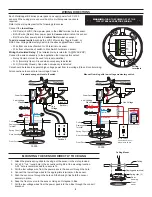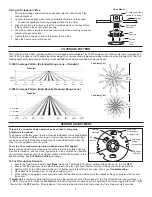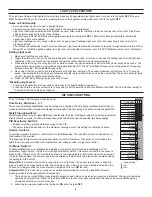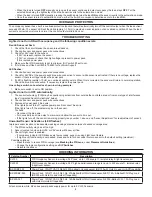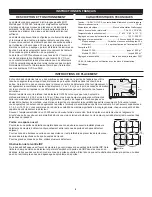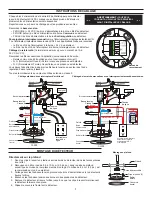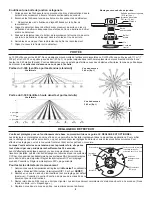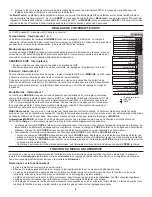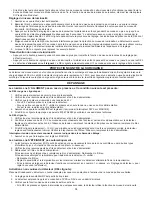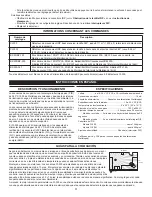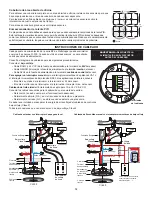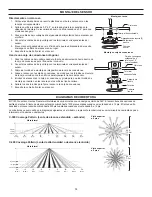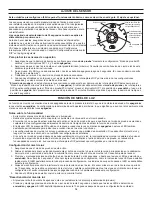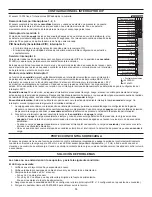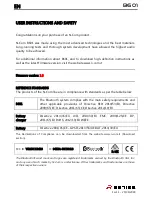
4
LIGHT LEVEL FEATURE
The Light Level feature holds lights off upon initial occupancy if adequate ambient light exists. It will not turn the lights
OFF
if they are
ON
. The default setting is for maximum, meaning that even the brightest ambient light will not hold the lights
OFF
.
Notes on Functionality
• Avoid mounting the sensor close to lighting fixtures.
• Adjust during daylight hours when ambient light in the area is at desired level.
• Light Level cannot be enabled while Test Mode is active. Either wait for Test Mode to expire or select any of the other Time Delay
settings before enabling the Light Level feature.
• PIR occupancy indicator LED may still respond when lights are being held
OFF
. LED will also flash periodically to indicate the
sensor has Light Level enabled.
• Light Level settings are only saved in the event of a power loss. Disabling Light Level and then reenabling it will not return it to
previous settings.
• If Test Mode is enabled after Light Level has been set, Light Level functionality will cease to function throughout the duration of Test
Mode. When Test Mode period expires, the Light Level functionality will resume, even if the DIP Switches remain set to Test Mode.
Setting Light Level
1. Make sure Test Mode is not active.
2. Toggle the state of the sensor, by briefly pressing the Light Level button, to include or exclude the lighting load from the light level
calibration. Open the Front Cover and locate the Light Level pusbbutton. See Sensor Adjustment.
3. Press and hold the Light Level button for 2 or more seconds, or until the detection LED turns
ON
. Do not exceed 5 seconds.* The
sensor enters setup mode, as indicated by the rapidly flashing LED. The LED will flash throughout the setup process. Occupancy
indication from the LED is disabled during setup.
4. Move away from the sensor to avoid interference with light level detection. The sensor measures the light level for a 10 second
period, then averages the readings and automatically sets the level that will be used as the new setting. The sensor will hold lights
off when the ambient light exceeds this setting.
5. When the LED stops flashing, replace the Front Cover.
*Disabling Light Level
• Pressing the pushbutton for 5 seconds or more resets the light to default (maximum).
• Press and hold the Light Level button for 5 seconds or until the detection LED turns
ON
and then
OFF
. The LED flashes rapidly for
10 seconds after the setting has changed.
DIP SWITCH SETTING
The CI-300 has 7 DIP switches under the cover.
Time Delay: Switches 1, 2, 3
The sensor will hold the lights
ON
as long as occupancy is detected. The time delay countdown starts when no
motion is detected. After no motion is detected for the length of the time delay, the sensor will turn the lights OFF.
Walk-Through Switch 4
Walk-through mode turns the lights
OFF
three minutes after the area is initially occupied, if no motion is detected
after the first 30 seconds. If motion continues beyond the first 30 seconds, the selected time delay applies.
PIR Sensitivity: Switch 5
• Minimum forces a reduced detection range for the PIR.
• Maximum forces the sensitivity to the maximum coverage area. This setting is constantly updated.
Service: Switch 6
To override all sensor functions, set DIP switch 6 to the
ON
position. The red LED will come on and stay on for
the duration of the override.
This bypasses the light level and occupancy detection control functions of the sensor, but still allows the
lights to be manually controlled with a light switch, low voltage switch, or Light Level button.
On Mode: Switch 7
The Manual
ON
function is facilitated by installing a momentary switch such as a Wattstopper LVS-1
Momentary Toggle Switch, or RS2-3 Low Voltage Momentary Switch. This switch connects to the sensor’s
Manual (Man.) Switch and +24V terminals as shown in the wiring diagram. Each time the switch is pressed,
the load changes state. The sensor’s operation as related to the manually operated switch is determined by
the setting for DIP Switch 7.
Manual ON
: In this mode, the switch is required to turn on the load. The sensor is then used to keep the
load on, based on occupant activity. After the time delay ends, if there is no movement detected within the
30 second re-trigger period the manual switch must be used to turn
ON
the load.
Automatic ON:
This mode uses occupancy as well as switch activation to turn the load
ON
. A manual
switch provides the following additional functionality:
1. The load can be turned
ON
by manual switch activation and it stays on as long as occupancy is detected. The sensor time delay
operates as programmed. When the load turns
OFF
due to lack of occupancy detection, the load can be turned
ON
again by
occupancy detection or switch activation.
2. Activating the manual switch while the load is
ON
turns the load
OFF
.
Switch#
5 minutes
10 minutes
15 minutes
20 minutes
25 minutes
30 minutes
30 seconds
1 2 3
Time Delay
Test Mode/20 min
5
Maximum
PIR Sensitivity
Minimum
6
Normal
Service
Service
7
Auto On
Manual On
On Mode
= ON
= OFF
= Factory Setting
4
Disabled
Enabled
Walk-Through


